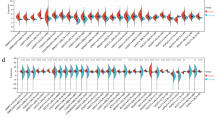Abstract
It has been reported that protein phosphatase, Mg2+/Mn2+ dependent, 1D (PPM1D) plays an important role in cancer tumorigenesis. However, the clinical and functional significance of PPM1D expression has not been characterized previously in non-small cell lung cancer (NSCLC). The purpose of this study was to assess PPM1D expression and to explore its contribution to NSCLC. We examined PPM1D messenger RNA (mRNA) expression in 53 NSCLC tissues and matched adjacent noncancerous tissues by quantitative reverse transcription PCR (qRT-PCR). Furthermore, the PPM1D protein expression was analyzed by immunohistochemistry in 157 NSCLC samples. The relationship between PPM1D expression and clinicopathological features was analyzed by appropriate statistics. Kaplan-Meier analysis and Cox proportional hazards regression models were used to investigate the correlation between PPM1D expression and prognosis of NSCLC patients. The relative mRNA expression of PPM1D was significantly elevated in NSCLC tissues as compared with adjacent noncancerous tissues (P < 0.001). The high expression of PPM1D in NSCLC tissues was significantly correlated with tumor grade (P = 0.006), tumor size (P = 0.017), clinical stage (P = 0.001), and lymph node metastases (P = 0.002). Kaplan-Meier survival analysis revealed that high PPM1D expression correlated with poor prognosis of NSCLC patients (P < 0.001). Multivariate analysis showed that PPM1D expression was an independent prognostic marker for overall survival of NSCLC patients. In conclusion, PPM1D plays an important role in the progression of NSCLC. PPM1D may potentially be used as an independent biomarker for the prognostic evaluation of NSCLC.



Similar content being viewed by others
References
Kamangar F, Dores GM, Anderson WF. Patterns of cancer incidence, mortality, and prevalence across five continents: defining priorities to reduce cancer disparities in different geographic regions of the world. J Clin Oncol. 2006;24:2137–50. doi:10.1200/JCO.2005.05.2308.
Jemal A, Siegel R, Ward E, Hao Y, Xu J, Thun MJ. Cancer statistics, 2009. CA Cancer J Clin. 2009;59:225–49. doi:10.3322/caac.20006.
Pisters KM, Evans WK, Azzoli CG, Kris MG, Smith CA, et al. Cancer Care Ontario and American Society of Clinical Oncology adjuvant chemotherapy and adjuvant radiation therapy for stages I-IIIA resectable non small-cell lung cancer guideline. J Clin Oncol. 2007;25(34):5506–18. doi:10.1200/JCO.2007.14.1226.
Lu G, Wang Y. Functional diversity of mammalian type 2C protein phosphatase isoforms: new tales from an old family. Clin Exp Pharmacol Physiol. 2008;35:107–12. doi:10.1111/j.1440-1681.2007.04843.x.
Bulavin DV, Demidov ON, Saito S, Kauraniemi P, Phillips C, Amundson SA, et al. Amplification of PPM1D in human tumors abrogates p53 tumor-suppressor activity. Nat Genet. 2002;31:210–5. doi:10.1038/ng894.
Li J, Yang Y, Peng Y, Austin RJ, van Eyndhoven WG, Nguyen KC, et al. Oncogenic properties of PPM1D located within a breast cancer amplification epicenter at 17q23. Nat Genet. 2002;31:133–4. doi:10.1038/ng888.
Lu X, Nguyen TA, Appella E, Donehower LA. Homeostatic regulation of base excision repair by a p53-induced phosphatase: linking stress response pathways with DNA repair proteins. Cell Cycle. 2004;3:1363–6.
Castellino RC, De Bortoli M, Lu X, Moon SH, Nguyen TA, Shepard MA, et al. Medulloblastomas overexpress the p53-inactivating oncogene WIP1/PPM1D. J Neurooncol. 2008;86:245–56. doi:10.1007/s11060-007-9470-8.
Saito-Ohara F, Imoto I, Inoue J, Hosoi H, Nakagawara A, Sugimoto T, et al. PPM1D is a potential target for 17q gain in neuroblastoma. Cancer Res. 2003;63:1876–83.
Loukopoulos P, Shibata T, Katoh H, Kokubu A, Sakamoto M, Yamazaki K, et al. Genome-wide array-based comparative genomic hybridization analysis of pancreatic adenocarcinoma: identification of genetic indicators that predict patient outcome. Cancer Sci. 2007;98:392–400. doi:10.1111/j.1349-7006.2007.00395.x.
Tan DS, Lambros MB, Rayter S, Natrajan R, Vatcheva R, Gao Q, et al. PPM1D is a potential therapeutic target in ovarian clear cell carcinomas. Clin Cancer Res. 2009;15:2269–80. doi:10.1158/1078-0432.CCR-08-2403.
Yu E, Ahn YS, Jang SJ, Kim MJ, Yoon HS, Gong G, et al. Overexpression of the wip1 gene abrogates the p38 MAPK/p53/Wip1 pathway and silences p16 expression in human breast cancers. Breast Cancer Res Treat. 2007;101:269–78.
Rauta J, Alarmo EL, Kauraniemi P, Karhu R, Kuukasjärvi T, Kallioniemi A. The serine-threonine protein phosphatase PPM1D is frequently activated through amplification in aggressive primary breast tumours. Breast Cancer Res Treat. 2006;95:257–63.
Satoh N, Maniwa Y, Bermudez VP, Nishimura K, Nishio W, Yoshimura M, et al. Oncogenic phosphatase Wip1 is a novel prognostic marker for lung adenocarcinoma patient survival. Cancer Sci. 2011;102:1101–6. doi:10.1111/j.1349-7006.2011.01898.x.
Zhang C, Chen Y, Wang M, Chen X, Li Y, Song E, et al. PPM1D silencing by RNA interference inhibits the proliferation of lung cancer cells. World J Surg Oncol. 2014;12:258. doi:10.1186/1477-7819-12-258.
Tu L, Liu Z, He X, He Y, Yang H, Jiang Q, et al. Over-expression of eukaryotic translation initiation factor 4 gamma 1 correlates with tumor progression and poor prognosis in nasopharyngeal carcinoma. Mol Cancer. 2010;9:78. doi:10.1186/1476-4598-9-78.
Liu Z, Li L, Yang Z, Luo W, Li X, Yang H, et al. Increased expression of MMP9 is correlated with poor prognosis of nasopharyngeal carcinoma. BMC Cancer. 2010;10:270. doi:10.1186/1471-2407-10-270.
Zhong X, Li M, Nie B, Wu F, Zhang L, Wang E, et al. Overexpressions of RACK1 and CD147 associated with poor prognosis in stage T1 pulmonary adenocarcinoma. Ann Surg Oncol. 2013;20:1044–52. doi:10.1245/s10434-012-2377-4.
Ganem NJ, Godinho SA, Pellman D. A mechanism linking extra centrosomes to chromosomal instability. Nature. 2009;460:278–82. doi:10.1038/nature08136.
Niu Y, Liu T, Tse GM, Sun B, Niu R, Li HM, et al. Increased expression of centrosomal alpha, gamma-tubulin in atypical ductal hyperplasia and carcinoma of the breast. Cancer Sci. 2009;100:580–7. doi:10.1111/j.1349-7006.2008.01075.x.
Conflicts of interest
None
Author information
Authors and Affiliations
Corresponding author
Additional information
Hua Yang, Xiao-Yu Gao, and Ping Li contributed equally to this paper.
Rights and permissions
About this article
Cite this article
Yang, H., Gao, XY., Li, P. et al. PPM1D overexpression predicts poor prognosis in non-small cell lung cancer. Tumor Biol. 36, 2179–2184 (2015). https://doi.org/10.1007/s13277-014-2828-6
Received:
Accepted:
Published:
Issue Date:
DOI: https://doi.org/10.1007/s13277-014-2828-6




